As a man, taking charge of your reproductive health is key. One big concern is testicular cancer. This cancer can be scary, but knowing about it and acting early can really help. Early detection can make treatment and recovery more likely.
This guide will cover the common signs of testicular cancer, why catching it early is important, and how men can watch their health. By knowing the signs, you can help take care of yourself and boost your treatment chances.
Key Takeaways
- Testicular cancer is a serious condition that requires early detection for successful treatment.
- Common symptoms include a lump or swelling in the testicle, as well as pain or aching in the scrotum.
- Performing regular self-examinations can help men identify potential issues early on.
- Seeking prompt medical attention for any changes or concerns is crucial for effective diagnosis and management of testicular cancer.
- Ongoing follow-up and support are essential for maintaining good reproductive health after treatment.
Understanding Testicular Cancer
Testicular cancer starts in the testicles, which make testosterone and sperm. It’s not common but is the top cancer type in men aged 15 to 35. Knowing the risks and causes, like undescended testicles and family history, helps men stay on top of their health.
What is Testicular Cancer?
It’s a cancer that grows in the testicles, found in the scrotum. These glands make hormones and sperm. If cancer cells form, they can cause a testicular lump or scrotal swelling. Finding it early and treating it quickly is key, as it’s highly treatable then.
Risk Factors and Causes
Some things can make getting testicular cancer more likely, including:
- Undescended testicles (cryptorchidism)
- Family history of testicular cancer
- Previous personal history of testicular cancer
- Certain genetic conditions, such as Klinefelter syndrome
- Environmental exposures, such as certain chemicals or radiation
We don’t know everything about what causes testicular cancer, but genes and the environment might play a part. Regular oncology screening and checking yourself can find it early, making treatment work better.

“Early detection is key when it comes to testicular cancer. Regular self-examinations and routine checkups can help catch this disease in its earliest, most treatable stages.”
testicular cancer symptoms, early detection, men’s health, oncology, self-exam
Finding testicular cancer early is key to a good outcome. It helps with treatment and survival chances. Men should know the signs to get medical help and tests.
Common symptoms include a lump or swelling in the testicle, feeling it’s heavy, and pain in the testicle or scrotum. Some may also notice penis discharge or discomfort.
Not all lumps mean cancer, but any unusual changes should be checked by a doctor. Regular self-exams are important for catching problems early.
The Importance of Testicular Self-Examination (TSE)
Doing regular testicular self-exams (TSE) helps men check their health. It’s a simple way to spot issues early. Knowing what your testicles normally feel like helps you notice any changes.
- Perform TSE monthly, ideally after a warm shower or bath, when the skin of the scrotum is relaxed.
- Gently roll and examine each testicle, feeling for any lumps, swelling, or abnormalities.
- If any changes are detected, it’s important to promptly consult a healthcare professional for further evaluation.
Early detection of testicular cancer is vital for a good outcome. Being aware of symptoms and checking your health helps. Men can act fast if they notice anything wrong.
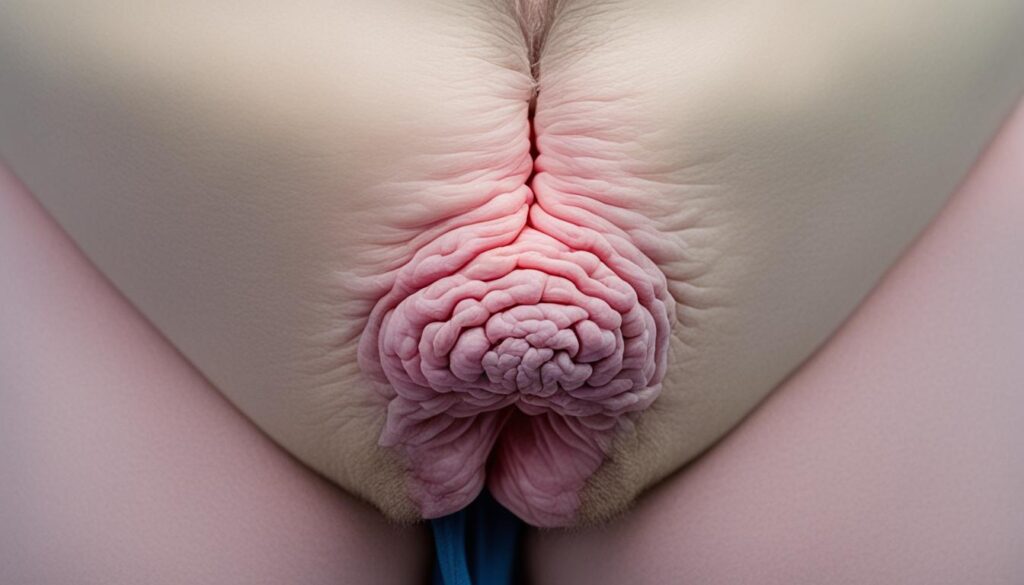
| Symptom | Description |
|---|---|
| Lump or Swelling in the Testicle | A painless lump or swelling in one of the testicles is one of the most common signs of testicular cancer. |
| Pain or Aching in the Scrotum | Unexplained pain or aching in the testicle or scrotum can also be a symptom of testicular cancer. |
| Penis Discharge | In some cases, men with testicular cancer may experience penis discharge or discomfort. |
| Heaviness or Dragging Sensation | A feeling of heaviness or a dragging sensation in the scrotum can also be a potential symptom of testicular cancer. |
Early detection is crucial for testicular cancer. Being proactive and aware of symptoms helps men protect their health. They can get medical help quickly if they have concerns.
The Importance of Early Detection
Finding testicular cancer early is key. It means better treatment options and better chances of beating the disease. By doing self-exams and seeing a doctor quickly if you notice anything odd, you can really help fight this cancer.
Here’s why finding testicular cancer early is so important:
- More treatment choices: Early on, testicular cancer can be treated with less invasive methods, like surgery or chemotherapy.
- Better outcomes: Catching it early means a higher chance of survival compared to finding it later.
- Fewer side effects: Early treatments often have fewer side effects, helping you live better during and after treatment.
Doing self-exams regularly and getting medical help fast is key for male reproductive health and oncology screening. By keeping an eye on your body, you can spot problems early. This leads to better treatment and outcomes.
| Testicular Cancer Stage | 5-Year Survival Rate |
|---|---|
| Stage I | 99% |
| Stage II | 96% |
| Stage III | 73% |
The table shows how crucial early detection is for testicular cancer. Finding it early greatly increases your chances of survival and successful treatment.
“Early detection is the key to beating testicular cancer. Regular self-examinations and prompt medical attention can make all the difference in the world.”
It’s important for men to take charge of their male reproductive health. Getting medical help quickly is key in fighting testicular cancer. By spreading the word and encouraging regular self-checks, we can boost oncology screening rates and save lives.
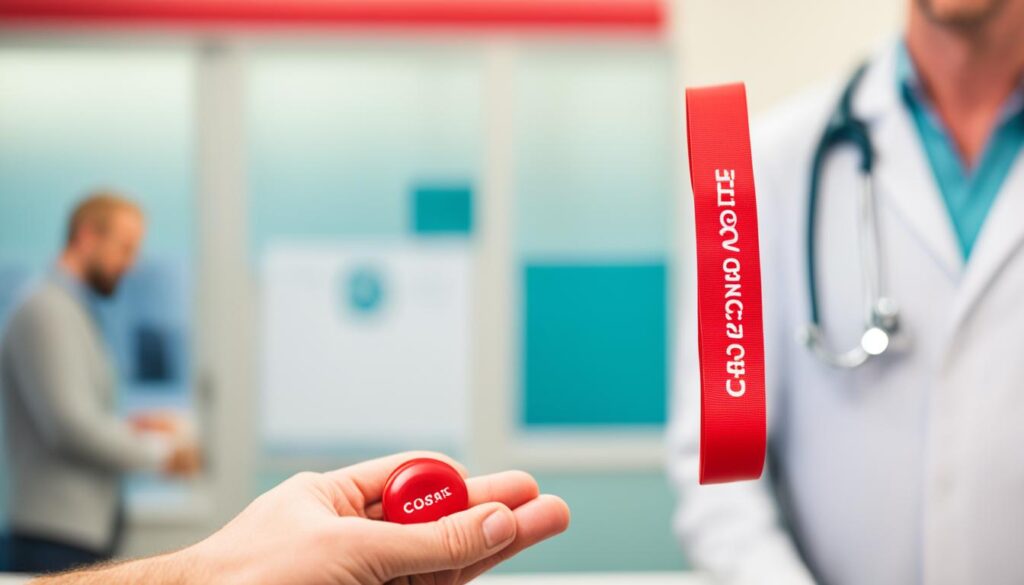
Common Testicular Cancer Symptoms
Testicular cancer is a serious condition, but catching it early can make a big difference. A common symptom is finding a lump or swelling in the testicle. This might not hurt or might feel like a dull ache in the scrotum.
Lump or Swelling in the Testicle
A lump or swelling in the testicle is often the first sign of testicular cancer. It could be a small, painless mass or a bigger swelling. Not all lumps are cancer, but any changes in your testicles should be checked by a doctor.
Pain or Aching in the Scrotum
Some men with testicular cancer feel a dull ache or discomfort in the scrotum or testicle. This pain might come and go or stay. Not all men with cancer feel pain, but noticing changes in your testicles is important.
Checking yourself regularly can help spot any problems early. If you find any unusual lumps, swelling, or discomfort, see your doctor right away. They can give you the right check-up and diagnosis.
| Symptom | Description |
|---|---|
| Lump or Swelling in the Testicle | A painless or uncomfortable mass or enlargement in the testicle |
| Pain or Aching in the Scrotum | A dull, persistent or intermittent discomfort or ache in the scrotum or testicle |
Other Potential Symptoms
A lump or swelling in the testicle is the main symptom of testicular cancer. But, there are other signs men should watch for. These include feeling heaviness or a dragging sensation in the scrotum, and any discharge or bleeding from the penis.
Heaviness or Dragging Sensation
Feeling heaviness or a dragging sensation in the scrotum could mean testicular cancer. This feeling of weight or discomfort is less common than finding a lump. Still, it’s crucial to tell your healthcare provider about any changes you feel.
Penis Discharge or Bleeding
Some men with testicular cancer may see discharge or bleeding from the penis. This symptom is rare but serious. It usually happens in advanced stages of the disease. If you notice this, see a doctor right away.
Early detection is key to beating testicular cancer. If you see any strange changes in your testicles or genital area, don’t wait. Call your doctor for an appointment.
“Catching testicular cancer early can make a significant difference in the prognosis and treatment options available.”
Being proactive and knowing the signs can help protect your health. It ensures you get the medical help you need on time.
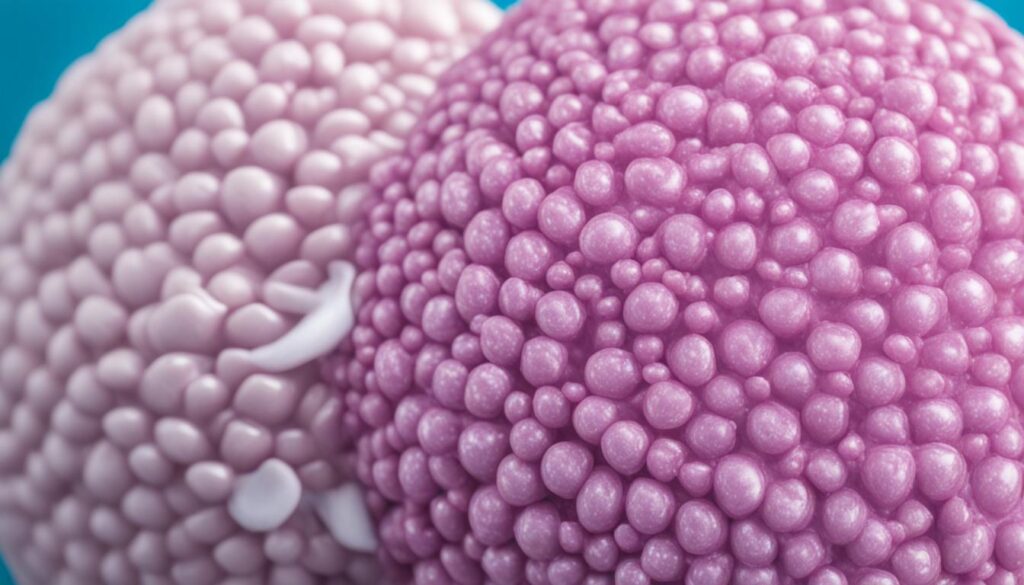
Testicular Self-Examination (TSE)
Regular testicular self-examinations (TSEs) are a key way for men to check their reproductive health. They help spot problems early. By learning how to do TSEs right, men can help prevent and detect cancer early.
How to Perform a TSE
Doing a thorough testicular self-exam is easy and can be done at home. Here’s a simple guide on how to do a testicular self-examination:
- Choose a time when you can focus, like after a warm shower or bath when your scrotum is soft.
- Stand in front of a mirror and look at your testicles for any lumps, swelling, or changes in size or shape.
- Use your thumb and fingers to gently roll each testicle, feeling for any unusual bumps or firmness.
- Notice the epididymis, a tube-like structure at the back of each testicle, as it’s a common spot for abnormal growths.
- If you find anything unusual, don’t worry, but make sure to see your healthcare provider for a check-up.
Regular testicular cancer self-exams can catch problems early. This leads to better treatment and more men’s cancer awareness. Adding this simple habit to your routine helps keep you healthy and well.
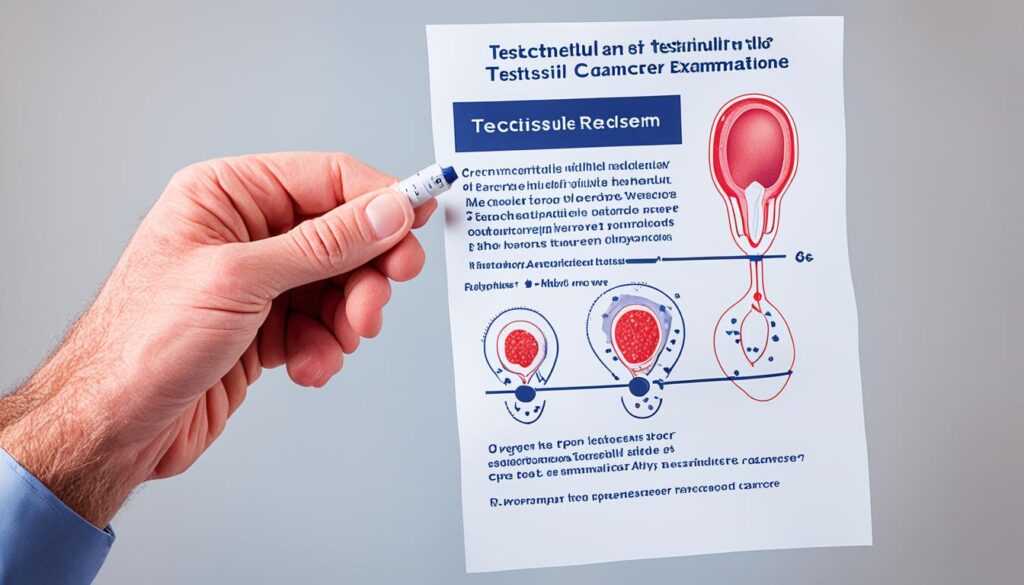
When to See a Doctor
If you see any changes or oddities in your testicles, like a lump, swelling, or ongoing pain, you should see a healthcare provider right away. Quick action is key for catching testicular cancer early and treating it effectively. This is a common cancer in men’s health.
Not all changes mean cancer, but it’s always best to be careful. Some signs that mean you should see a doctor include:
- A painless lump or swelling in the testicle
- A feeling of heaviness or aching in the scrotum
- A sudden onset of pain in the testicle or scrotum
Spotting testicular cancer early is crucial for men’s health. Getting medical advice quickly can greatly improve your chances of a good outcome and reduce the disease’s effects.
“Don’t hesitate to see a doctor if you notice any changes in your testicles. It’s better to be safe than sorry when it comes to your health.”
Regular self-checks and quick doctor visits can really help in finding and treating testicular cancer. Don’t delay – take control of your when to see a doctor and focus on your health.
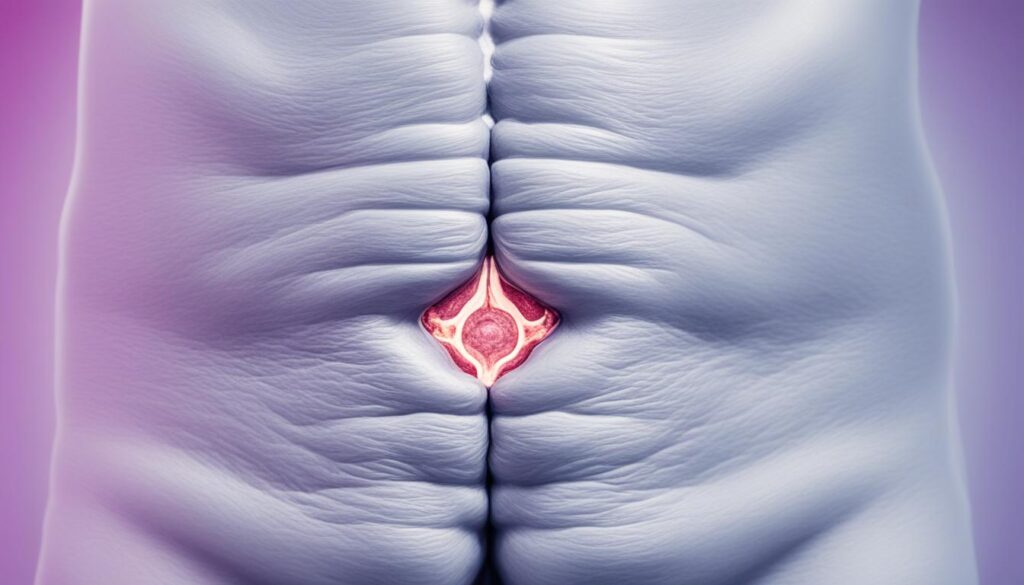
Diagnostic Tests and Procedures
Healthcare providers start with a thorough physical exam for testicular cancer diagnosis. They check the testicles for any unusual lumps or swelling. They also examine the abdomen and other areas for signs of the disease spreading.
Physical Examination
The doctor asks the patient to stand and relax their scrotum during the exam. Then, the doctor feels each testicle for any unusual masses or changes. This hands-on check is key in finding early-stage tumors during the testicular cancer diagnosis process.
Imaging Tests
If the exam suggests testicular cancer, the doctor will order more imaging tests. An ultrasound is often used to see the testicles and nearby areas clearly. Sometimes, a CT scan or MRI is needed to understand the cancer’s spread better.
Imaging tests are crucial in oncology screening. They help doctors make an accurate testicular cancer diagnosis and plan treatment. Early detection thanks to these tests can greatly improve patient outcomes and treatment success.
| Diagnostic Test | Purpose |
|---|---|
| Physical Examination | To identify any abnormalities, such as lumps or swelling, in the testicles |
| Ultrasound | To provide detailed images of the testicles and surrounding structures |
| CT Scan | To get a better understanding of the extent of the cancer |
| MRI | To get a better understanding of the extent of the cancer |

Treatment Options for Testicular Cancer
Getting a testicular cancer diagnosis can feel overwhelming. But, there are many effective treatment options available. The right treatment depends on the cancer’s stage, type, your health, and what you prefer. It’s key to talk with an oncologist to create a treatment plan that works best for you.
Surgery is a main treatment for testicular cancer. It might mean taking out the affected testicle (orchiectomy) or removing lymph nodes in the abdomen (retroperitoneal lymph node dissection). These surgeries can help treat the cancer and stop it from spreading.
Chemotherapy is another way to fight testicular cancer. This treatment uses strong medicines to kill cancer cells in the body. It’s often used for advanced or spread-out testicular cancer.
Radiation therapy might also be an option. This treatment uses high-energy beams to target and destroy cancer cells. It’s often used with other treatments.
The main goal of treating testicular cancer is to get the best outcome while keeping your health and quality of life good. By working with your oncology team, you can look at all the treatment options. This helps you make choices that fit your needs and what you prefer.
| Treatment Option | Description | Potential Benefits |
|---|---|---|
| Surgery | Removal of the affected testicle (orchiectomy) or lymph nodes (retroperitoneal lymph node dissection) | Effective in treating the cancer and preventing its spread |
| Chemotherapy | Use of powerful medications to target and destroy cancer cells throughout the body | Particularly effective in treating advanced or metastatic testicular cancer |
| Radiation Therapy | Targeted use of high-energy beams to eliminate cancer cells | Often used in combination with other therapies |
The best treatment for testicular cancer is decided by you and your oncology team. By looking at all the options and making informed choices, you can take an active part in your care. This helps you work towards a successful recovery.
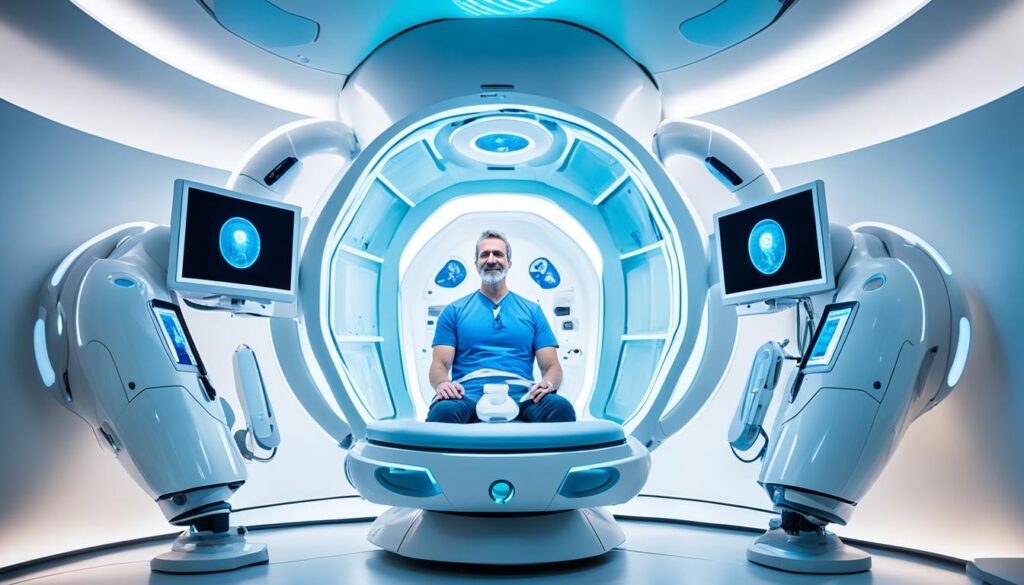
Survivorship and Follow-up Care
Surviving testicular cancer is a journey filled with hope and resilience. Early detection and the right treatment make the prognosis excellent. But, it’s important to keep up with follow-up care to prevent the cancer from coming back and manage treatment side effects.
As a survivor, it’s key to stay close to your healthcare team. They can help create a care plan that looks after your physical and emotional health. This plan will address the unique needs you might face during survivorship.
Regular Check-ups and Monitoring
Seeing your oncologist or urologist regularly is crucial for follow-up care. These visits help your team watch for cancer coming back and manage treatment side effects. This includes issues like infertility or hormonal changes.
Addressing Long-term Concerns
Survivors often deal with long-term issues, like physical, emotional, and sexual health problems. Your healthcare team can offer advice and support. They make sure your well-being is a top priority during this phase.
Embracing a Healthy Lifestyle
Living a healthy life is key to your overall health as a survivor. This means regular exercise, eating well, and managing stress with activities like meditation or counseling.
Working with your healthcare team and being proactive about your health helps you take charge of your testicular cancer survivorship. This way, you can live a fulfilling life ahead.

“Survivorship is not just about beating cancer, it’s about embracing life to the fullest.”
Raising Awareness and Support
Teaching men about testicular cancer awareness and catching it early is key to better health. Groups and health experts use Testicular Cancer Awareness Month in April to push for self-checks. They also encourage talking about men’s health and offer support resources.
Testicular Cancer Awareness Month
April is Testicular Cancer Awareness Month. It’s when health experts, groups, and caring people focus on this men’s health issue. They work together to spread the word and give out educational materials.
- Workshops and seminars on performing regular self-exams
- Social media campaigns highlighting the signs and symptoms of testicular cancer
- Partnerships with local communities to distribute informational materials
- Fundraising events to support testicular cancer research and support services
Joining in Testicular Cancer Awareness Month helps a lot. It promotes catching cancer early, starts important health talks, and links people to the right resources and support.
“Early detection is key in the fight against testicular cancer. Testicular Cancer Awareness Month provides a platform to empower men to take charge of their health and prioritize regular self-examinations.”
Working together to support testicular cancer patients and their families is an ongoing task. But, the effect of these efforts can greatly improve outcomes and save lives.
Preventive Measures and Lifestyle Changes
There’s no sure way to prevent testicular cancer, but making lifestyle changes can lower the risk. As a men’s health advocate, I think it’s key to take steps early. This helps with overall health and catching the condition early.
Keeping a healthy weight is a top preventive step. Being overweight can up the risk of testicular cancer. By staying active and eating right, you can keep a healthy weight.
It’s also key to avoid harmful chemicals and radiation. Men should watch their work and living environments. Some substances raise the risk of testicular cancer. Talking to doctors can help spot and reduce these risks.
Checking yourself regularly is a simple way to find testicular issues early. Men with a family history or other risk factors should learn how to check themselves. This should be part of their health care.
| Preventive Measure | Benefit |
|---|---|
| Maintaining a Healthy Weight | Reduces the risk of testicular cancer |
| Avoiding Harmful Exposures | Mitigates exposure to chemicals and radiation linked to testicular cancer |
| Practicing Regular Self-Examinations | Facilitates early detection of any abnormalities |
By making these lifestyle changes and taking steps to prevent testicular cancer, men can help protect their health. Talking often with doctors is key to a good plan for prevention and early detection.
“Early detection is key when it comes to testicular cancer. By making lifestyle changes and incorporating regular self-examinations, men can take an active role in their health and improve their chances of catching this condition in its earliest stages.”
Conclusion
Testicular cancer is a serious but treatable cancer if caught early. Men can help by knowing the symptoms, like lumps or swelling in the testicles. They should also do regular self-exams to keep an eye on their health.
It’s key to find testicular cancer early. Quick doctor visits and correct diagnosis are vital. Men can help fight this disease by staying informed and being proactive in their health care.
Even though fighting testicular cancer can seem tough, it’s highly treatable if found early. By being proactive and watching their health, men can greatly improve their chances of a good outcome. This way, they can live fulfilling lives even after dealing with testicular cancer.

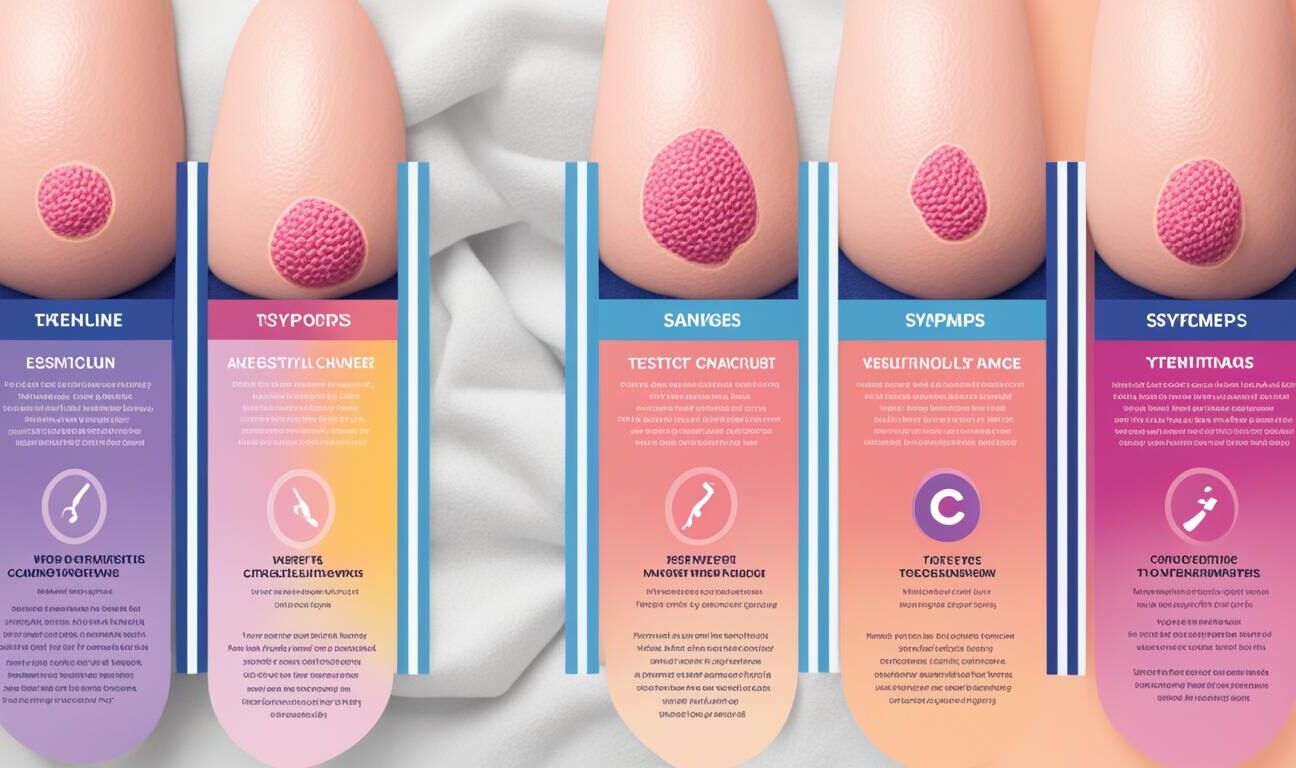





Leave feedback about this